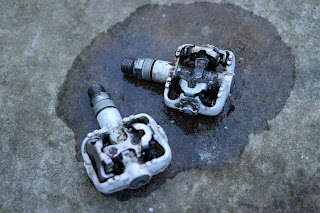I continue to carefully work through and rationalise the spares bins, taking stock of what’s still relevant/required and what can be released. Much of this boils down to contact points. For example, I ride exclusively with recessed SPD/pattern and Time ATAC systems. No sense in clinging on to Keo patterns.
Nothing wrong with them per se. Rather, I prefer the convenience of being able to walk (rather than the undignified hobble) without chewing the composite cleat, or gouging holes in expensive linoleum.
With that in mind, I’ve just taken delivery of these rather fetching Wellgo M)94B 9/16 SPD Shimano Cleat Compatible Sealed Bearing Pedals. These are the silver versions, which should also keep their looks longer than a black, or similarly painted counterpart. Some painted finishes tire quicker than others.
Powder-coated versions, including these XLC can prove very hardy, others can flake away, with repeated entry/exit. Much of this boils down to price I.e. quality of powder coating and process I.e. properly blasted bodies given a high-quality zinc-rich primer coat fare best.
Saddles are another component that can require re-homing.
Older/cheaper models can go, higher-end/genuinely compatible models, stay. Switching to the Pro Turnix has proven a wise decision. More supportive than the Stealth, 2g heavier than the otherwise very agreeable and cheaper BBB Echelon. However, the Turnix offers plenty of support, without any loss in pedaling efficiency.
Older/cheaper models can go, higher-end/genuinely compatible models, stay. Switching to the Pro Turnix has proven a wise decision. More supportive than the Stealth, 2g heavier than the otherwise very agreeable and cheaper BBB Echelon. However, the Turnix offers plenty of support, without any loss in pedaling efficiency.
Flooding and similar life-changing destruction has been a theme in some parts of the UK. Here, though blustery, winds have ranged between 27 and 40 mph. The former proving passable, albeit still challenging riding conditions.
Save for some very cold nights, there’s no hint of the snow, assured by the “red top” tabloid press for several months now. Spiked tyres have remained slumbering in storage.
I have a love/hate relationship with waterproof socks. The truly impervious TPU lined versions are genuinely impervious-right to the cuff-line.
However, they also tend to become unpleasantly clammy. Boiled in the bag feet, leading in some instances to athletes’ foot and similar infections. Fabrics which aren’t completely waterproof but highly water-resistant and fast-wicking are my preference. For these reasons, the Oxford Products Ox Sox https://www.sevendaycyclist.com/oxford-ox-socks have proved extremely agreeable.
They’re not cycling-specific, which isn’t necessarily a deal-breaker, it adds to their versatility in many respects. However, more traditional touring shoes and MTB booties are as snug as you’ll find compatible.
The relentlessly wet conditions require more frequent maintenance. I’m still running the White Lightning Extreme Wet lube and I’m past the 300mile marker on a single helping, with little sign of it relenting. Hardly prodigious perhaps, 400+isn’t uncommon from a stodgy wet formula.
Motor and chainsaw oils are surprisingly effective and extremely cheap. https://www.sevendaycyclist.com/cheap-as-chips-chain-lubes provided of course, you’re very vigilant when it comes to cleanliness. i.e. wiping the side plates, rings, derailleur cages at least weekly. Otherwise, that sludgy grinding paste will consume chains and other drivetrain components at a rapid rate. Its reckoned 10spd chains should be retired by the time wear registers .6, 11 speed at .5.
Chain checking tools are sensible investments (although wear can be accurately assessed using a very accurate ruler). Basic chain checkers can be had for £3, or less. More sophisticated digital fare carries a commensurate price tag but their improved accuracy may recoup monies longer-term i.e. not retiring chains just in time-not too early, or too late.
Theoretically extending the longevity of more expensive components. During my rationalization, I uncovered this electroplated BBB model. One that I’d had since 2007 but that had been AWOL for a few years. It had fallen from the tool board and beneath the chest freezer.
Arguably the simplest of this breed, it has a couple of unique features. See the two cutouts? One is designed to remove valve cores, the other is a 5,6 and 8mm box spanner. Not the most useful functions on a contemporary build perhaps but better than dead space.
Anyhow, the chain function is incredibly simple to use. Place between a designated length of chain, if the teeth sink into the links-low enough that it sits horizontal, the chain is shot. My Univega’s Sram is showing moderate signs of wear but not pensionable just yet. A few hundred miles-three weeks at the current rate before I switch to an FSA I have in stock.
































